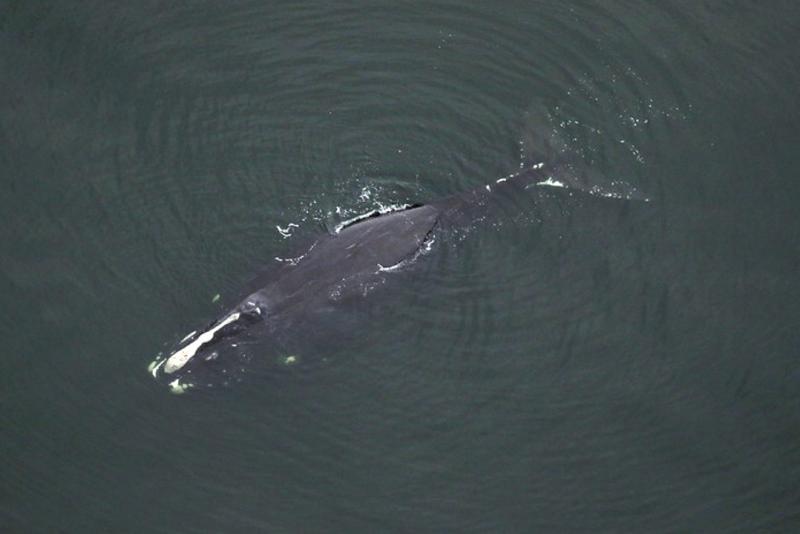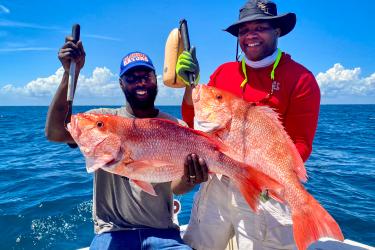North Atlantic right whale migration is underway! As of December 2, biologists have five confirmed sightings of potential right whale moms. The first right whale of the 2019–2020 season was spotted Saturday, November 23, six miles off Jacksonville, Florida. The whale, known to biologists as “Harmonia” is a 19-year-old female. According to scientists, she last gave birth in 2016.
In addition to "Harmonia" other whales spotted include "Harmony," "Arpeggio," and "Slalom" off South Carolina, and "Naevus" (off Georgia).
Making Right Whale Migrations Safe
North Atlantic right whales are on the move along the Atlantic coast of the United States. NOAA is cautioning boaters to give these endangered whales plenty of space and to be vigilant while underway to avoid accidental collisions with whales. We are asking commercial fishermen to remove unused gear from the ocean to help avoid entanglements. We also ask that they use vertical lines with required markings, weak links, and breaking strengths.
Every winter, many right whales travel more than 1,000 miles from their feeding grounds off Canada and New England. They migrate to the warm coastal waters of South Carolina, Georgia and Florida's east coast. These waters in the southern United States are the only known calving area for the species—an area where females regularly give birth during winter.
North Atlantic right whales are protected under the Endangered Species Act and the Marine Mammal Protection Act. Scientists estimate there are approximately 400 remaining, making them one of the rarest marine mammals in the world. NOAA Fisheries recently named the North Atlantic right whale its newest Species in the Spotlight.
"North Atlantic right whales are in serious trouble," said Barb Zoodsma, right whale biologist for NOAA Fisheries. "We have lost 30 right whales in U.S. and Canadian waters since 2017. The number of right whale deaths is unsustainable for a population of a little more than 400 animals, particularly because we estimate that there are only about 100 breeding females who are producing fewer calves each year."
"These southern waters are where right whales give birth and nurse their young. This is a vulnerable phase for right whales, making it extremely important for people to be aware of the whales' movement and migratory patterns," said Tom Pitchford, wildlife biologist for the Florida Fish and Wildlife Conservation Commission. "Right whales are fasting while here, so any disturbance could affect behaviors critical to the health and survival of the species.”
Entanglement and Other Threats to Right Whales
Entanglement in fixed commercial fishing gear is a major threat to right whales. There are restrictions on where and how commercial traps, pot gear, and gillnet gear can be set. These restrictions include seasonal closures and gear modifications such as sinking groundlines, weak links, and gear markings.
To reduce the risk of harassment and collisions between right whales and boats, federal law requires vessels and aircraft to stay at least 500 yards away from right whales. Vessels 65 feet and longer are also required to slow to speeds of 10 knots or less in Seasonal Management Areas along the East Coast. This includes the calving and nursery area.
The federal Ship Strike Reduction Rule does not regulate vessels under 65 feet. However, collisions with smaller vessels have occurred. They result in injuries and death to whales and expensive damage to boats.
"Right whales often swim and rest just below the surface, and are invisible to approaching boats and ships," said wildlife biologist Clay George of the Georgia Department of Natural Resources. "It's important for operators of ships and large yachts to follow vessel speed rules, and for boaters to slow down whenever possible."
U.S. speed restrictions are in place in various areas along the mid-Atlantic November 1–April 30 and in the southeast U.S. calving area November 15–April 15.
NOAA and its partners conduct aerial and vessel surveys off the coast of Florida and Georgia throughout the calving season. These surveys are used to:
-
Monitor the seasonal presence of right whales and their habitat use.
-
Assess calving rates.
-
Detect dead, injured and entangled whales.
When observed, trained biologists also respond to disentangle animals and investigate injuries and mortalities.
To report right whale sightings, especially dead, injured, or entangled whales, please contact NOAA Fisheries at (877) WHALE-HELP (877-942-5343) or the Coast Guard on marine VHF channel 16.



